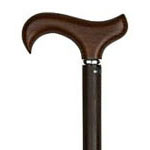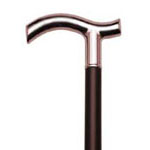Cane Trivia
Probably more than you ever wanted to know about canes in general
|
History
- The name "cane" is shared with and derived from the material most often used for the earliest walking aids: "the hollow, jointed stem of a tall grass, esp. bamboo or sugar cane, or the stem of a slender palm such as rattan."
- Walking sticks were an item of high fashion and status for centuries. Their popularity dropped off some time in the mid 20th century.
- There is a common myth that a license was required to carry a cane in England during the 18th century, because it was considered a weapon. However, this legend stems from a satirical article in the Tatler. The article actually implied that one needed a fashion license.
|
Facts
- There is a sport called Canne de Combat. It originated in France and is essentially cane fighting. There are also several martial arts that include cane techniques.
- Many canes have handles that screw off to reveal a hidden compartment in the handle or shaft. Throughout history these canes have been used to smuggle cigars, alcohol, drugs, weapons, documents, and pretty much anything else that will fit.
- A screw off handle also commonly has a knife or sword built into it, concealed in the shaft.
|
Terminology
- Handle: The top part of the cane or walking stick, held in the hand.
- Shaft: The full stick, or body, of the cane.
- Collar: A decorative ring of ivory, metal, or other material found between the handle and shaft.
- Tip: The bottom of a cane, usually a material that will grip the ground well and prevent slipping. Typically rubber for everyday use, but a variety of special tips are made for different conditions, such as a spiked tip for icy weather or a multi-tip for extra stability.
- Ferrule: A metal tip, found almost exclusively on fashion items as it provides poor grip.
- Grip: Any kind of material (padded, moulded, etc.) added or sculpted onto the handle for easier or more comfortable use.
- Cane: 1) A stick with a bent or curved handle. 2) A stick with a rubber tip, used as a walking aid.
- Walking Stick: 1) A straight stick, sometimes with a decorative knob at the top. 2) A stick with a ferrule tip, used as a fashion accessory.
The definitions of "cane" vs "walking stick" vary from source to source. Some online retailers or collectors distinguish the two by the type of handle, and others by the tip and/or intended purpose. With so much confusion the terms have become almost interchangeable.
|
Proper Use of a Cane
- Measurement: When the user is standing straight, the top of the handle should reach the wrist joint. When the handle is held in the hand, the elbow should be slightly bent. A cane that is too tall or too short will make the user unstable and put unnecessary strain on the back, potentially causing further injury.
- Walking: Most physical therapists and medical experts strongly recommend that the cane is used in the hand opposite the injured leg. While this is usually much easier on the back for long-term use, many variables must be taken into account including injury type, other physical disabilities, and personal preference. Some people even experience worse pain when using the cane as recommended, so there really is no guaranteed right way to use a cane. However, using it incorrectly can cause further injury. Always consult a physical therapist if you are using a cane for medical reasons to make sure you are using it the best way for your specific needs.
|
Most Common Types of Handles
There are many different types of handles, including a wide selection of molded comfort grips and a limitless variety of sculpted animal heads or other shapes, but these are the ones you'll see most frequently.
Tourist
The Tourist is the handle most commonly associated with a cane. It is an inverted "J" shape and is also known as a Hook handle. |  |
Derby
A stylish and ergonomic shape, this handle is most popular among cane users because it is the most comfortable for most people to use. |  |
Opera
A straight or slightly curved handle bending at a 90° angle from the shaft is known as the Opera handle. It is an inverted "L" shape and is also called a Flat handle. |  |
Fritz
Similar to the Derby, this handle was designed specifically for arthritis sufferers. Common netlore claims it was designed by a German Count in the 16th century, but all references to this seem to lead in a big circle with no solid original source. |  |
Offset
For the offset handle, the shaft bends at a slight angle before curving into a handle perpendicular to the main shaft. This centers the handle perfectly over the support of the shaft for ideal balance. The offset handle usually has a padded grip. |  |
T
The least creatively named handle is exactly what it sounds like: a T shape. |  |
Knob
By some definitions, a knob handle makes the item a walking stick, not a cane (see Terminology section above). This handle is not very comfortable as a walking aid and is more common for a fashion or decorative piece. |  |
|
